Rating: 4/5
For years, smartphones have followed a predictable design: a flat rectangle that fits in your pocket. But mobile technology is constantly evolving, pushing the boundaries of what’s possible. Foldable phones represent the next step in this evolution by breaking the mold, offering a glimpse into a future where our devices can transform to meet our needs.Late 2019 witnessed a landmark event when a new chapter ‘unfolded’ with the launch of the world’s first foldable phone, bringing the promise of futuristic, pocketable tablets and a fresh approach to mobile technology.
But this new frontier has had its obstacles. Just like any emerging tech, they’re not without their quirks and compromises. The companies are still perfecting the design and ironing out flaws. Having said that, the foldable phones are — slowly and steadily — carving out a space in the smartphone market. The Google Pixel 9 Pro Fold is a prime example – a device that showcases the potential of foldables while also highlighting the areas where they still need to mature.
The Pixel 9 Pro Fold is priced at Rs 1,74,999 for the lone 16GB RAM + 256GB storage variant. It comes in a single Obsidian colour option. We used the phone for a few weeks and here’s what we think of it.
Google Pixel 9 Pro Fold design
The strength of the Google Pixel 9 Pro Fold lies in its design that has drastically changed as compared to the first generation foldable Pixel smartphone. While the OG Pixel Fold did not launch in India, a quick comparison shows a huge contrast between them. The last year’s model was compact with a passport-size body while the new one is more like a full-fledged candybar phone. Moreover, its name and design pretty much aligns with the other smartphones in the Pixel 9 series, hence, the design change seems a positive step.
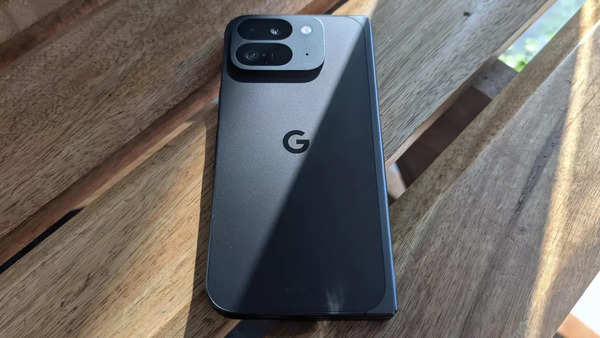
For example, in the folded state, the Pixel 9 Pro Fold is pretty much similar to the Pixel 9 which we recently reviewed. There’s a 6.3-inch OLED Actua display with 20:9 aspect ratio and 1080 x 2424 pixel resolution at 422 ppi. Unlike the Pixel 9 Pro XL (Review) model which gets the LTPO panel, the foldable offering gets 60–120 Hz variable refresh rate and up to 2,700 nits peak brightness. The major difference between the Pixel 9 and Pixel 9 Pro Fold display is that the latter has more rounded corners and the phone is overall a bit bulkier to hold.
Unlike the offerings from Vivo and Samsung that have a taller stance, the Pixel 9 Pro Fold phone has a wider stance. Though the taller stance makes a foldable phone slightly easier to hold due to its weight and bulky form factor, the wider design makes the display more usable. During our review, when we shifted our data from Pixel 9 Pro XL, there wasn’t much of a difference in our communication with the homescreen.
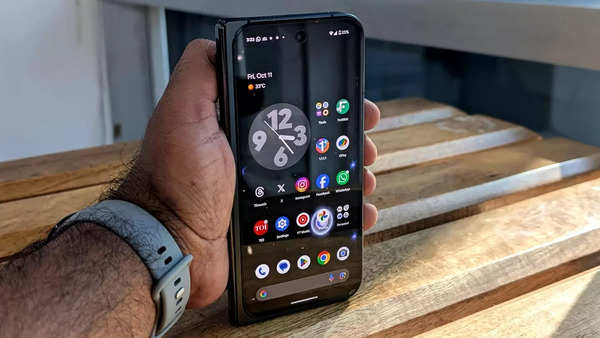
We had no trouble using the phone outdoors, as the display remained clear and legible under direct sunlight. The display dynamically adapts to the environment, ensuring vibrant visuals whether we’re in bright sunlight or a dimly lit room. With a responsive touch and a smooth 120Hz refresh rate, navigating the interface, scrolling through social media and app switching feels effortless.
The premium display delivers vivid colours, deep blacks and balanced contrast for an immersive viewing experience. This also applies to the inner display though it is a bit glossy due to the flexible protective covering on the display.
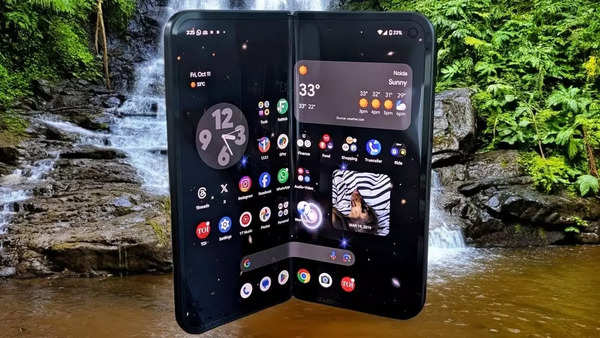
In the unfolded state, the Pixel 9 Pro Fold pretty much has a squarish footprint — like there are two Pixel 9 smartphones joined together. There’s an 8-inch OLED Super Actua Flex LTPO display with 2076 x 2152 pixel resolution and up to 2,700 nits peak brightness. The phone is easier to hold due to its thin design and lightweight. The expanded canvas provides a larger area to put widgets and the apps that have been optimised in accordance with the screen are neat to interact with. (More on this in the software section).
Coming to durability, the Pixel 9 Pro Fold gets Corning’s Gorilla Glass Victus 2 protecting both the exterior display and the matte-finished rear panel. The rear camera module, with its rounded rectangular design, subtly protrudes from the back. The floating island looks like two Pixel 9 camera modules stacked one above the other.
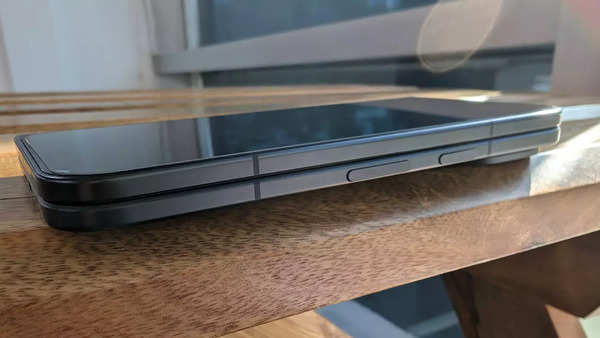
The fingerprint sensor is embedded on the power button which neatly sits on the right side in line with a natural thumb position when we hold the phone. All this is housed in a sturdy aluminium chassis. The hinge has high-strength design and is reinforced with an aerospace-grade aluminium alloy.
The Pixel 9 Pro Fold offers an IPX8 water resistance rating, allowing for worry-free use around pools or in light rain. However, it lacks a dust resistance rating due to the delicate hinge mechanism. Additionally, the phone opens flat.
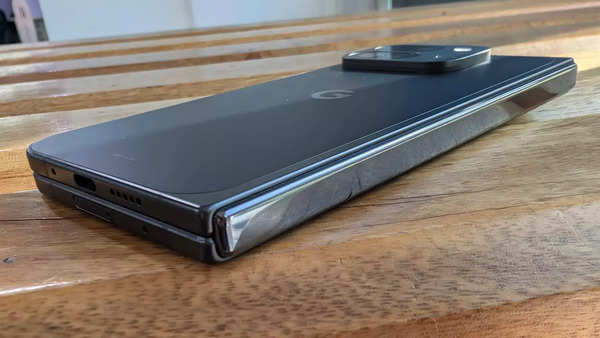
The hinge is hard enough to let us hold the foldable screen in any angle between zero degrees to 180 degrees, and is soft enough to allow us to unfold the phone without putting in any extra effort. The matte finish provides the Pixel 9 Pro Fold a premium look and it is one of the thinnest foldable smartphones available in the market right now.
Google Pixel 9 Pro Fold software and performance
The success of a foldable smartphone not only depends on the design and all the sophisticated hardware but also on how optimised the software is to be used on a bigger screen as well as the transition from outer screen to the inner. Remember we talked about Pixel 9 Pro Fold being two Pixel 9 smartphones side-by-side — that comes into play in software.
The real question is how well the apps use that extra space. The phone comes with Android 14 out-of-the-box. Interestingly, we primarily used the 6.3-inch cover display for everyday tasks like messaging and email. This proved convenient, despite the phone being a bit thicker than a conventional candybar phone. This also eliminated the need to constantly unfold the larger screen.
However, when we needed that extra bold or larger picture, we unfolded the phone to be greeted with similar brightness and sharpness, making it ideal for watching videos. Due to the book design, reading on the Pixel 9 Pro Fold is another positive for the optimised experience.
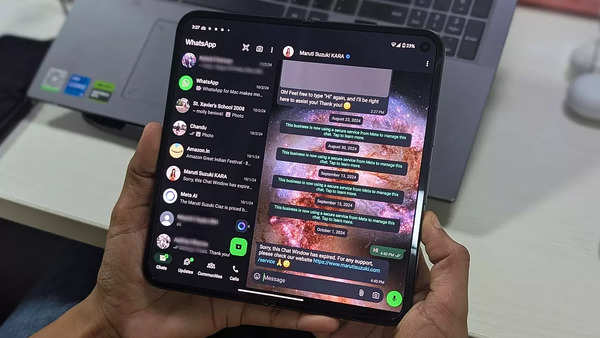
The screen has a noticeable crease down the middle, but it doesn’t significantly impact the user experience. Notably, the phone didn’t fully replace our tablet for entertainment purposes but it surely eliminated the need and reduced the weight of carrying another device and a charger when going on a short flight.
Coming to app optimisation, the Pixel 9 Pro Fold excels in some areas — when using Google’s apps, for instance, Google Meet that utilises both screens for a more engaging video call experience. Some other Google apps Gmail and Photos app, also take advantage of that extra screen real estate.
Apart from that, third-party apps that we regularly use are a hit-or-miss. For example, Meta-owned WhatsApp utilises the expanded screen space pretty well, while another app from the same company — Facebook — is a bit odd to look at on a wider screen. Instagram offers too much black space (white if you use Light Mode) while X is better when it’s not opened on the unfolded screen.
Moreover, there is still a need for developers to make games compatible or optimised for large screens on foldables. Multitasking is also enhanced by the foldable design. Running two apps side-by-side feels more natural and productive on the larger inner display.
Apart from optimisation, there’s one thing that didn’t impress us — the app drawer interface. In the unfolded state, when we pull up the app drawer, the apps/ or screen in the background remains sharp, essentially merging with the app drawer and making a hotch-potch of the UI. We would have liked the background to be blurred when the app drawer is pulled up in the unfolded state.
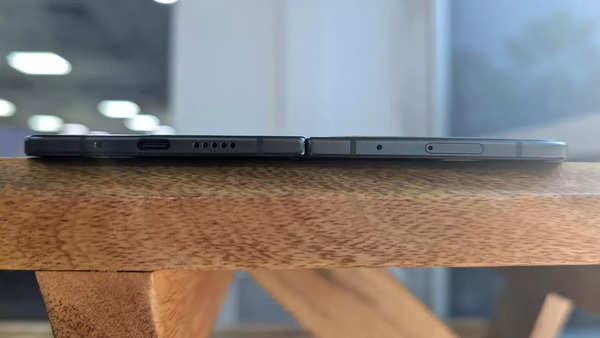
All in all, the optimisation of software, apps and games are the key to unlocking the full potential of a foldable screen. While Google has made strides with its second foldable phone, the challenge posed to third-party app developers of adapting the Android interface for this unique form factor remains.
AI software on the Pixel 9 Pro Fold
The Pixel 9 Pro Fold gets the same AI capabilities as the Pixel 9 Pro XL and Pixel 9 that we reviewed recently. All the AI features are powered by the Gemini Nano language model that is handled on-device by Tensor G4. These features, some operating locally and others relying on cloud processing, aim to enhance daily productivity and user experience.
Familiar AI features like Circle to Search, which allows users to highlight on-screen elements for quick information retrieval, and the AI-powered Google Assistant (now known as Gemini) are present. Additionally, the Recorder app with real-time transcription, AI wallpapers, and Live Translate continue to offer valuable functionality.
New additions in the set include the Pixel Screenshots app, which intelligently organises and retrieves screenshots based on user queries, and an upgraded Weather app with AI-generated summaries and conversational interaction.
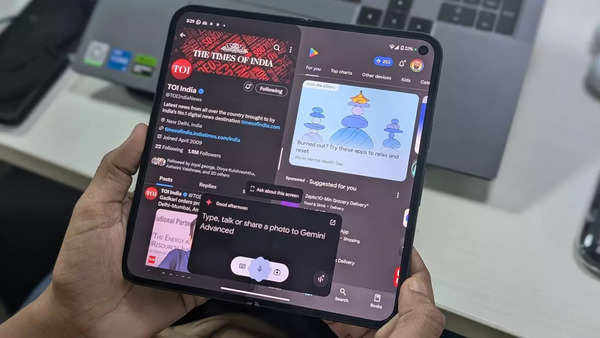
Gemini Live enables natural, flowing conversations with the AI, providing up-to-date information, though occasional inaccuracies may occur.
Photography also benefits from refined AI features like Best Take for optimising group photos and Photo Unblur for sharpening old images. Magic Eraser removes unwanted background elements, while the updated Magic Editor allows for object repositioning, intelligent cropping, and background alterations.
Two standout new features are “Add Me,” which seamlessly merges separate photos to include everyone in a group shot, and “Zoom Enhance,” which uses AI to improve image quality at high zoom levels.
When it comes to performance, the Pixel 9 Pro Fold is powered by Google’s Tensor G4 chip — the same SoC that is fitted in the other Pixel 9 series of smartphones. An upgrade from its predecessor despite being built on the same 4nm process as the Tensor G3, the G4 features newer ARM cores and increased clock speeds for both CPU and GPU, resulting in improved performance and graphics. Google also claims a 20% boost in battery life compared to the G3.
A notable improvement is the reduction in heating issues that plagued earlier Pixel models. While some warmth can still be observed during extended use, it’s significantly less pronounced than before. As mentioned before, the Tensor G4 isn’t designed to compete with top-tier chips like Qualcomm’s Snapdragon or Apple’s A series in terms of raw power. Google’s focus with Tensor is on optimising AI and machine learning tasks, allowing for on-device processing.
In everyday use, the Pixel 9 Pro Fold performs smoothly and efficiently — whether browsing the web, streaming videos, or using productivity apps, the phone handles tasks with ease.
Google Pixel 9 Pro Fold camera
The Pixel 9 Pro Fold has 5 cameras in total, with a versatile triple rear camera system. This includes a 48MP main sensor with an f/1.7 aperture and an 82-degree field of view, a 10.5MP ultrawide lens with autofocus, an f/2.2 aperture, and a 127-degree field of view, and finally, a 10.8MP telephoto lens with 5x optical zoom, an f/3.1 aperture, and a 23-degree field of view.
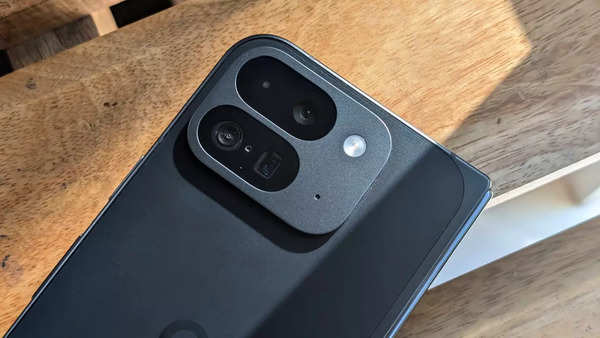
While this setup allows for Super Res Zoom up to 20x with optical quality at 0.5x, 1x, and 5x, this is essentially a downgrade from the world-class cameras that we reviewed in the Pixel 9 Pro XL. Further, for selfies, the foldable phone gets a 10MP front-facing camera with an f/2.2 aperture and an 87-degree field of view. The inner camera mirrors the front camera’s specs with another 10MP sensor.
The cameras are okay to shoot with. Despite being a notch below as compared to the non-foldable siblings, they provide acceptable shots for a Pixel smartphone. The photos, as usual, rely on heavy AI magic and post processing before they can be previewed.

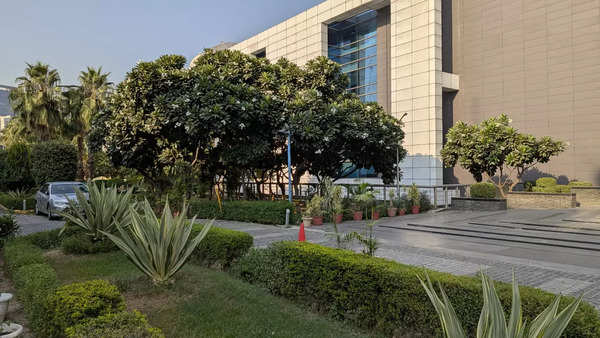



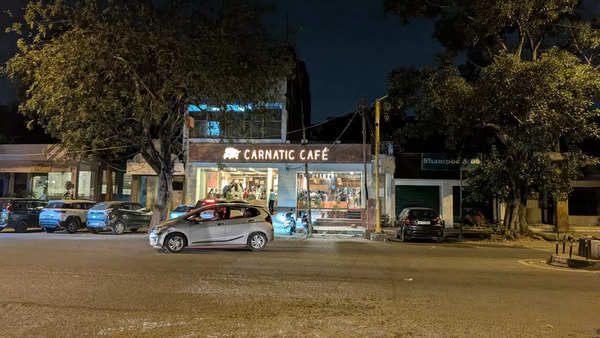


So if you want a Pixel smartphone that has top-grade camera quality, you can go for the Pixel 9 Pro/ Pixel 9 Pro XL. However, if your priority is a foldable Pixel smartphone, a lower quality camera is a trade-off for a larger screen and foldable form factor.
Google Pixel 9 Pro Fold battery
The Pixel 9 Pro Fold houses a 4,650mAh battery — which is 50mAh lesser than the Pixel 9 smartphone. Interestingly, despite powering two screens, the phone manages to last a full day. A full charge takes about an hour and 15 minutes with a 45W USB-C charger, which is not included in the box, and we bought it separately.
Verdict
The Google Pixel 9 Pro Fold is a compelling foldable phone that has a sleek design, reminiscent of a regular smartphone, though its weight and foldable nature set it apart. While the exterior display is excellent for everyday tasks, the inner 8-inch display shines for tablet-like activities such as watching videos, reading ebooks and using apps optimised for larger screens. Multitasking is also enhanced by the spacious foldable screen.
The foldable screen also comes with some trade-offs like an under-powered camera setup, though the phone offers impressive photography capabilities. The processor handles the daily tasks easily and decent battery life lasts a full day. Barring some minor drawbacks, like some apps not optimised for the larger screen, the Rs 1.75 lakh Pixel 9 Pro Fold offers a unique and enjoyable user experience that showcases the potential of foldable phones.

